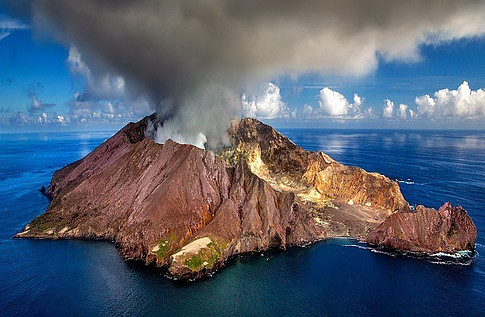
Active volcanoes are usually found in parts of the world where earthquakes are common – the constant subsurface movement of earth and material makes volcanoes possible. Long-dead volcanoes and evidence of ancient volcanic activity can be found elsewhere – such as Arthur’s Seat in Edinburgh, Scotland.
A channel, the primary outlet for a volcano, is formed when pressure forces molten rock (magma) to the surface through a fault. This channel is usually the main outlet for further eruptions, although other vents may appear. A major eruption may blow the whole top off a mountain.
The molten rock, usually known as lava when it reached the surface, may be of two kinds:
- Granite Lava – which is viscous and slow moving
- Basalt Lava – which flows more rapidly at speeds of 8-16 kph (5 – 10 mph).
Granite lava tends to block the vent of the volcano. As a result, this will cause pressure to build that will eventually clear the vent by an explosion that will shower lava and pieces of mountain around for considerable distances and cause fires as a result.
Lava
Although it is possible to outrun or even out walk most basalt lava flows, their movement is relentlessly forward until they reach the bottom of a valley or eventually cool off. They will crush and bury anything in their path. Actually, lava flows are probably the least hazard to life produced by an eruption because the able-bodied can get out of the way. Other dangers are NOT so easily
Missiles
Volcanic missiles which can range from pebble-size fragments to great lumps of rock and ‘bombs’ of hot lava, can be scattered over considerable distances. A shower of volcanic ash can fall over a much greater area, some dust being carried to great heights, and these are dispersed around the world affecting weather conditions.
If you are close to a volcano during an evacuation, wearing hard helmets like those worn by building workers, motorcyclists or horse riders will give some protection. Over a wider area, where evacuation may not be necessary, protection should be worn against the effects of ash and any rain that comes with it.
Ash
Volcanic ash is actually not ash at all. It’s actually pulverized rock forced out by a cloud of steam and gases. Abrasive, irritating and heavy, the weight of this “ash” can cause roofs to collapse. It smothers crops, blocks roads and other transportation routes and waterways. Combined with toxic gases, volcanic ash can cause lung damage to the very young, old and those with respiratory problems.
Only if one is very close to the volcano are the toxic gases concentrated enough to poison a healthy individual. However, when sulfur dioxide in the ash cloud is combined with rain, strong concentrations of sulfuric acid (and sometimes others) are created. This strong mixture can burn skin, eyes and mucous membranes. If possible wear goggles (such as ski-goggles or a snorkeling mask) that seal around the eyes. Do NOT wear sunglasses – these will not help.
Use a damp cloth over the mouth and nose, or an industrial dust mask if available. Once you reach shelter, remove clothing, thoroughly wash exposed skin and flush eyes with clean water.
Gas Balls
Believe it or not, a ball of gas and dust may roll down the side of a volcano at a speed of more than 100 mph (160 kph). This phenomenon (called a “nue ardente” or glowing cloud by scientists) is red-hot and moves too fast to be outrun. Unless there is a strongly built underground shelter nearby, the only chance for survival is to submerge underwater and hold your breath for the half-minute or so it will take to pass.
Mudflows
The volcano may melt ice and snow and cause a glacial flood or, when combined with earth, create a mudflow known as a “lahar”. This can move up to 60 mph (100 kph) with devastating effect, as in Colombia in 1985.
In a narrow valley a lahar can be as high as 98 ft (30 m) high. They are a potential danger long after the major eruption is over. They are also a potential risk when the volcano is dormant if it generates enough heat to produce meltwater that is retained by ice barriers. Consequently, heavy rains may cause it to breach the ice.